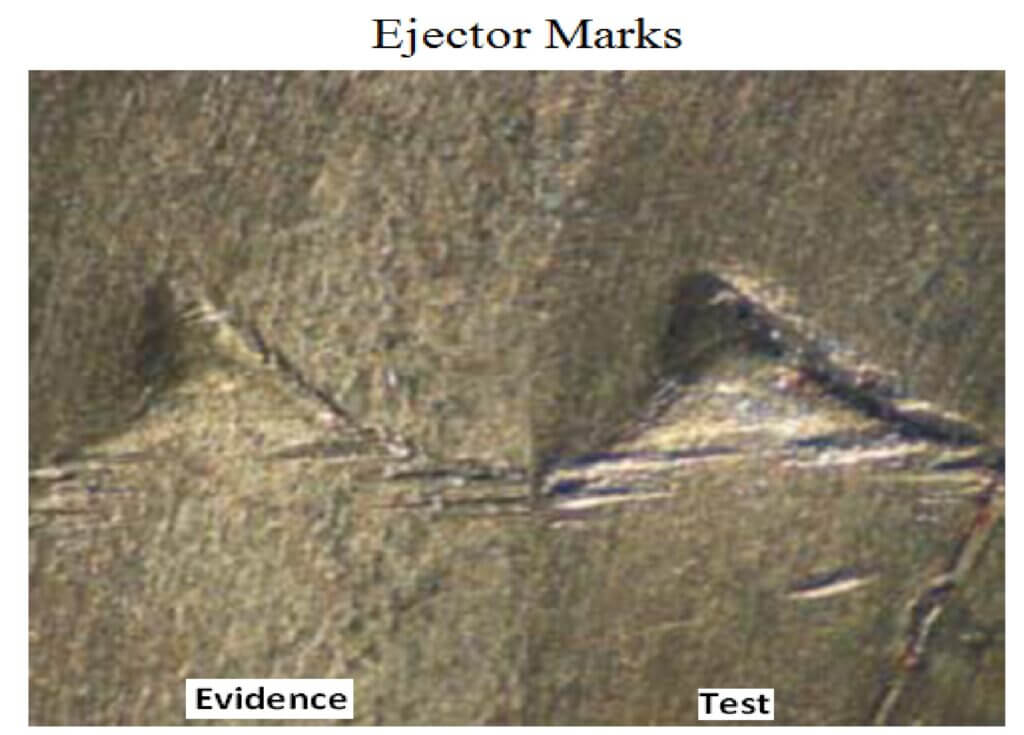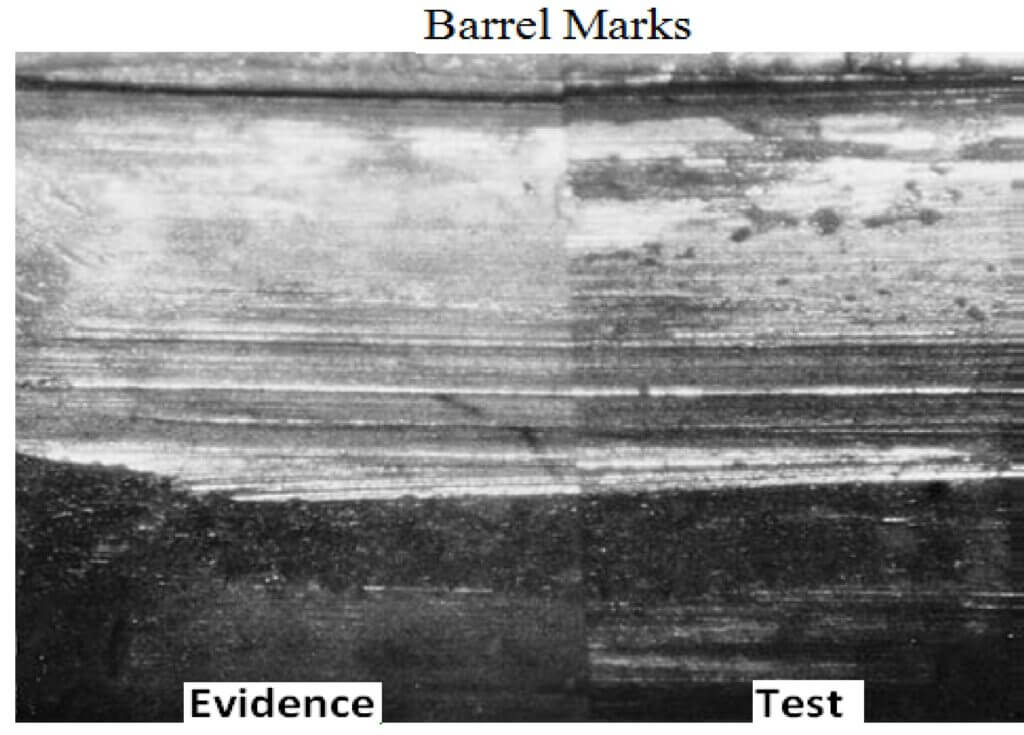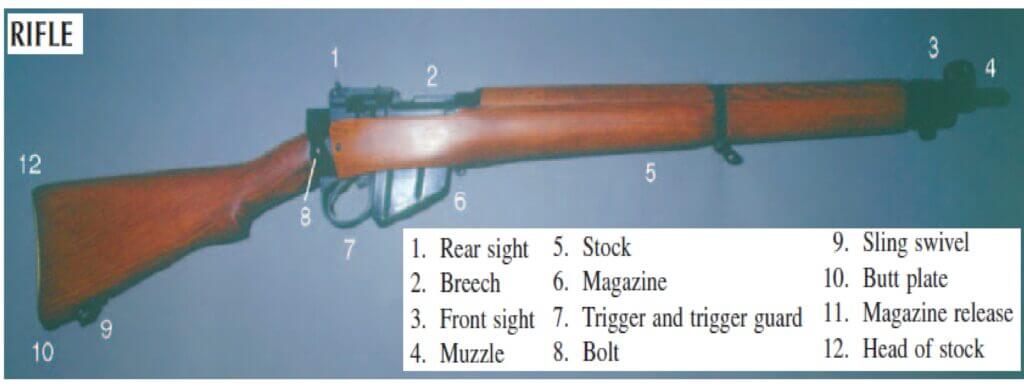Nature of work – Ballistics section is engaged in examining and opining on exhibits related to firearm shooting cases. In addition ballistics expert team from the section also perform scene of crime investigation/reconstruction job in important/high sensitivity cases of complex nature as and when required. The opinion of ballistic expert given as ‘Assistant Chemical Examiner is admissible as evidence without personnel Appearance before the Hon’rable court as per section 293 (i)(IV)(A)of CrPC, However, as and when required, the experts appear before Hon’rable court for deposition
Exhibits being examined in the section – Firearms and their parts, ammunition- Live and fired cartridges, Fired Projectiles- Bullets, pellets, wads etc, Target material-Garments, Skin, Glass, Metal, wood etc. and explosive residues.
Type of examination and opinion
1. Firearms – make whether factory made/country made, what is the Calibre /bore, whether action mechanism is working, whether has been fired etc.
2. Live cartridge- Make calibre/bore, Type of Projectile etc.
3. Fired Cartridge Cases- Make, Calibre/bore, Examination of Characteristic markings – .firing pin impression, breech-face Marks, extractor marks, ejector marks, chamber marks etc., Linkage with firearm based on microscopic comparison tor characteristic marks.
4. Fired Bullets- Calibre bore, Examination of characteristic Markings – regular rifling marks, barrel marks etc., Linkage with firearm based on microscopic comparison for characteristic marks.
5. Fired pellets, wads etc, linkage with other relevant exhibits.
6. Target material- Examination of Garments, Skin, Glass, metal, Wood etc. for presence of gunshot hole/gunshot residues, Range determination based on close range phenomenon e.g. blackening, gunpowder marks etc, Range determination based on pellet dispersion patterns.
7. micro-chemical analysis and chromatographic analysis of explosive residues to identify the explosive material used in explosion. The fundamental aspects of various types of firearms, ammunition, the linkage of fired ammunition with suspected firearm, range determination etc are briefly described in the literature appended herewith.
References:
- Hatcher, J.S., Jury, F.J. & Weller, J., (1957) Firearms Investigation, Identification and Evidence, The Stackpole Co., Harrisburg, Pennsylvania, USA.
- Burrad, G., (1951) The Identification of Firearm and Forensic Ballistics, Herbert Jenkins, London.
- Mathew, J.H., (1962) Firearms Identification, Vol. I, The University of Wisconsin Press, Madison, USA.
- Jauhari, M., (1980) Identification of Firearms, Ammunition and Firearm Injuries, Bureau of Police Research and Development, Govt. of India, New Delhi, India.
- Feigl, F., (1962) Spot Tests in Inorganic Analysis, Elsevier Publishing Co., Netherlands.
ARM-AMMUNITION LINKAGE
The identification of the firearm which fired the incriminating cartridges, bullets or the other projectiles is one of the most important aspects of forensic ballistics. The identifications, like fingerprints, are positive in most of the cases. They have great evidentiary value in linking the criminal with the crime.
PRINCIPLES
When a firearm is discharged, the cartridge case comes in contact with the firing pin, the breech face, the extractor, the ejector and the chamber. The fired projectiles come in contact with the lead and the barrel. All these parts of a firearm are made of steel. During their manufacture they undergo processes like culling, hammering, reaming, grinding, filing and polishing. Various tools are used in their manufacture. The surface profiles of the tools used continue to change due to wear and tear as the tools work on steel. The finished surface profiles of the firearms after undergoing such operations are, therefore, never alike even when the two surfaces are made with the same set of tools, one after the other. Consequently, all the firearms, even the two barrels of the same firearm, show complete individualities. This individuality has also been established by actual experiments carried out in the initial stages, of the development of this science by Colonel Goddard:
A long barrel was bored and grooved. It was then cut into six pieces to make six barrels. Bullets fired through the six barrels were correctly identified in respect of the individual pieces.
The peculiarities of the various parts of a firearm are enhanced with the use of the firearm due to the wear and tear and the accidental damage. When a cartridge is fired, the cartridge case and the bullet come in close contact with the relevant parts of the firearm. A negative profile of the surface of the firearm coming in contact with the surfaces of the fired cartridge case or of the bullet is imprinted. The profile pattern is called the thumbprint of the firearm. It permits individualization of the firearm.
The cartridge cases and bullets are made of softer materials than the steel of the firearm. The marks producing surfaces, therefore, do not change substantially for a long time or with continued use. The firearm can be identified in respect of the fired ammunition even when the firearm is recovered after a long time. The interval between the commission of the crime and recovery of the firearm is, ordinarily, too small to allow extensive changes in the barrel.
If the firearm is ill-kept, misused or intentionally tempered with to change the profile pattern of the surface, the fired ammunition then may or may not be identifiable. It depends upon the changes so produced. Each case may be decided only after the thorough examination.
Sometimes a very old firearm is used in the commission of the crime. Due to the extensive use, the inner surface of the barrel of the firearm gets ‘washed’. Its bore becomes larger. A bullet fired through such a firearm does not ‘house’ properly in the barrel. It is, consequently, not imprinted with the complete thumbprint of the firearm.
A loose fit bullet is marked imperfectly. A test bullet of the right calibre, therefore, may not carry all the marks from the barrel. A lead bullet (or a slug) of slightly larger diameter is prepared and pushed through the barrel. It takes up most of the marks from the barrel and proves useful for comparison, but not always.
Class and Individual Characteristics
The position, size and the general shape of the firing pin, the breech face, the extractor, the ejector and of the chamber marks on a cartridge are the class characteristics of the firearm. The finer details of all these marks constitute the individual features/ characteristics of the firearm.
In a fired bullet, the calibre, number, width, depth, direction and twist of the grooves and land, form the class characteristics. The finer details (striations) in the in the lands and grooves are individual characteristics of the firearm.
The fire arms of the same make and model imprint common class characteristics on the fired ammunition. The firearms of the different makes and of the different models of the same make imprint different class characteristics.
The individual features are always different. No two firearms have the same individual characteristics.
Identification Basis of the fired Cartridge
The cartridges when fired, as already seen, come in close contact with relevant parts the firing pin, the breech face, extractor, ejector and chamber of the firearm. The parts imprint their negative facsimile on the cartridge case. In addition, if the case slides, striated marks are imprinted on the case.
Firing Pin
The firing pin strikes the cartridge on the percussion cap and imprints its mark. The impact explodes the cap composition, the flame and the heat produced, rapidly convert propellant charge into gases. The high pressure developed presses the case against the firing pin. The clarity of the firing pin marks is thus enhanced.
The firing pin scrape marks produced on the base are equally useful.
The firing pin marks, alone permit the identification in about 95% cases.
Breech Face
The surface of the action block surrounding the firing pin (and opposite to the cartridge base in the loaded gun) is called the breech face. On firing, the gases push the cartridge case violently against the breech face, which imprints its negative profile on the cartridge base.
The breech face profile is highly characteristic. It, alone, is sufficient for the identification of the firearm used, if the imprint of the profile on the base of the cartridge is clear and sufficient.
The breech marks are not always available on the fired cartridges cases, however breech face marks alone are sufficient for identification of the weapon.

Chamber
The chamber marks are observed rarely on the fired ammunition. Ordinarily some defect or some deposit in the chamber imprints its negative profile on the tubular portion of the cartridge case when it develops pressure on firing. An over-sized cartridge case may also tend to get imprinted with the chamber mark.
The chamber marks are often found in the cartridges fired from the improvised firearms as there is no proper obturation space to allow for the normal expansion of the cartridge case on firing. The chamber marks permit the identification of the firearm from the fired ammunition like the other marks.
Extractor
Extractor marks like the chamber marks are rarely prominent. They may permit the identification of the firearm whenever they are imprinted clearly. Extractor marks help in fixing the orientation of the cartridge in the chamber.
The orientation is often helpful in locating, the part of the breech block (or other parts) which may have imprinted the marks on the cartridge case.
Ejector
In the automatic and the semi-automatic firearms the ejector marks the cartridge case when it strikes against it, in its backward motion. The ejector is so positioned that the fired shell after striking the device is pushed out of the firearm. The ejector marks are frequently identifiable and link the fired shells with the firearms. The clarity of the marks, however, varies tremendously from one firearm to another and even from one shot to another in the same firearm. The marks are, therefore, more useful as class characteristics to fix or eliminate the make of the firearms. They permit individualisation of the firearm when the marks imprinted are sufficient and clear.

Identification Basis of the Bullet
The bullets received marks from the barrel. The lands of the barrel engrave grooves on the bullets. The grooves of the barrel may also scrape the surface of the bullet. The marks on the ‘lands’ of the projectiles are the result of this scraping. They are usually present when the bullets are made of lead.

The leads sometimes scrape the bullets. The marks are called slippage marks. The muzzle also gets burred due to the crowning, if the barrel has been sawn off or due to accidental damage. The additional nooks and corners so produced, mark the bullets. The frequently utilised marks for the identification of the firearm are, however, those engraved by the lands of the barrel. The groove scrapes are useful whenever they are present. The slippage marks are seldom utilised. The slippage marks should prove useful when the land and groove marks are not adequate. It is, however, difficult to prepare the adequate specimen slippage marks for the comparison purposes. It is important to note that:-
• The dirt (rust, soil ete.) on the bullets or in the barrels affects the clarity of the marks. It mutilates or modifies the marks.
• The barrel engraves the marks on the lead bullets easily. The marks are mutilated or destroyed with equal ease. The marks engraved on the jackets of the bullets are retained better.
• The bullets passing through the intermediate target (like the wire gauze, the glass, wood ete.) may carry scratches through the edges of the holes. The scratches mayor may not hinder the identification marks.
•The crimped edges of the cartridge case may mark the projectile coming out of the same. The marks are the minute scratches parallel to the axis of the bullet. The marks should not cause confusion in the identification work.
•Bullets passing through a bulged barrel may get engraved with the overlapping duplicate set of marks because the bullets jump through the bulge. The duplication may hinder the identification of the projectile in respect of the firearm.
• A bullet fired from the revolver sometimes carries slippage (or shaving) marks. This happens because the projectile has to jump the gap – the distance between the barrel. The chamber and the barrel bore are not perfectly aligned. In the process, some parts of the bullet are shaved or scratched by the edges of the barrel at the breech end. These marks may interfere with the identification of the firearm which has fired the projectile. However, they may prove useful in some cases. For example, when the usual marks are imperfectly imprinted or the marks are mutilated, they may link the firearm and the projectile.



